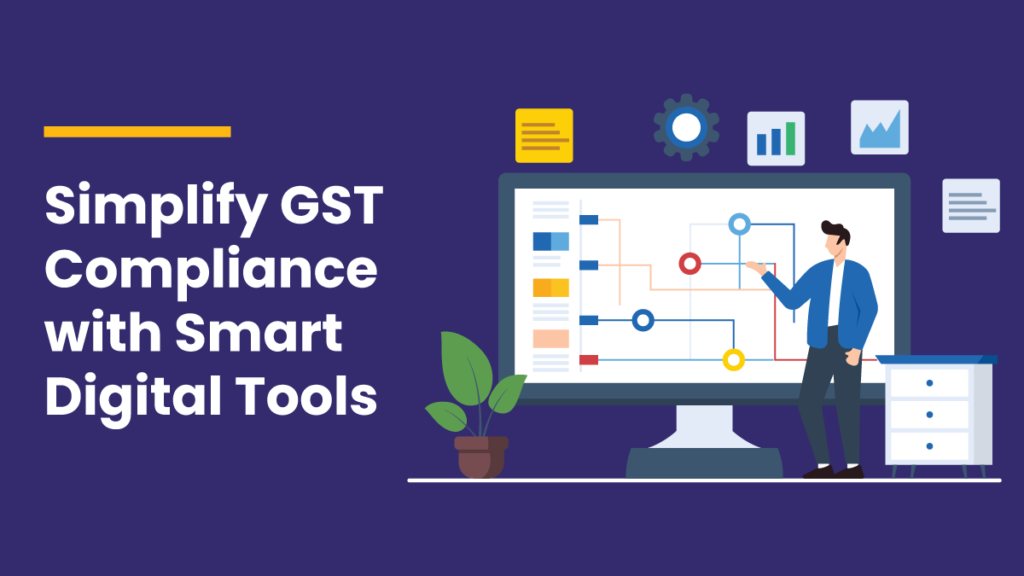Small and medium enterprises (SMEs) contribute to more than 45% of manufacturing output in India. Besides, more than 40% of the total workforce in India is employed in this sector. Thus, SMEs greatly influence the economic aspects of this country, which demands that they understand the need to comply with the Goods and Services Tax (GST).
Considering the critical calculations, complex tax filing procedures, and maintenance of invoices, staying GST-compliant is a daunting task for most SME businesses. Here comes the need for digital tools that can automate GST compliance procedures.
Keep reading to learn how such applications can streamline GST compliance for SMEs.
Understanding GST Compliance for SMEs
When it comes to Goods & Services Tax (GST) for SMEs, there are specific rules and regulations that need to be followed. This includes paying taxes, filing GST returns, and keeping a record of their sales and purchases.
Businesses are liable for penalties upon missing the deadlines or filing the invoice details inaccurately. Thus, it is essential to introduce innovative tools to maintain GST compliance digitally.
Benefits of Leveraging Digital Tools for GST Compliance
SMEs can avail of multiple benefits by using digital tools for GST compliance:
-
Provides Real-time Updates
Businesses using GST compliance tools can get real-time updates on their IT filing status, deadlines, tax rules, etc. This software instantly updates any changes in the GST regulations, keeping firms aligned with the latest changes.
-
Maintains Accuracy
With digital tools, GST calculation can be performed accurately without any error. Based on the sales and purchases of the business, these applications compute GST automatically, avoiding the possible mistakes of manual calculations.
Thus, companies can trust digital tools for error-free data entry and calculation to enable hassle-free GST returns.
-
Saves Time and Money
Digital GST compliance tools help save a lot of time and money by automating the calculation process. Thus, firms can reallocate these resources to their core operations, which also increases their long-term growth prospects.
What are the Features to Look for in GST Compliance Software?
Businesses should check for the following features while selecting a GST compliance tool:
-
Data Security
It is essential to ensure the security of these digital tools since GST compliance deals with sensitive financial information. Thus, business owners must select GST compliance software with high-security standards and data encryption to ensure that they do not face any accidental loss of tax data or cyber threats.
-
Integration
Another crucial factor to consider while selecting a GST compliance tool is whether it integrates with the company’s current business accounting software. It automatically helps import invoices, sales, and purchases-related data, reducing errors and saving time.
-
GST Filing
Business owners should select a standard GST compliance tool that supports all types of GST requirements and filing, such as GSTR-1 and GSTR-3B. Also, they must be able to file GST returns seamlessly and generate an e-way bill for the transportation of goods.
-
User-friendly Interface
One of the most essential features to look for in a digital tool is its interface. An ideal GST compliance software should be one that can be operated even with minimum technical knowledge.
Its intuitive and simple interface should facilitate seamless navigation without any complicated features.

Exploring the Key Digital Tools for GST Compliance
Here are some of the best digital tools for GST Compliance that SMEs can use:
GST Billing Software
This software helps in automatic tax calculations, GST return filing, invoice generation, etc. Apart from this, the GST billing software reduces the risk of payment mistakes by keeping track of a business’s purchases and sales.
Some of the best GST filing software, like myBillBook, includes additional features like business management, e-way billing, inventory management, customised invoices, all-in-one billing, etc.
Besides, some platforms also generate tax reports automatically and provide deadline reminders for seamless GST billing.
GST Compliance Dashboard
Such applications allow firms to view their GST filing status, tax liabilities, and upcoming deadlines, all in a single dashboard. They provide a complete overview of a business’s tax data and help owners meet deadlines on time and remain organised.
GST Return Filing Tool
Business owners can use this software to file accurate GST returns. One can generate GSTR-1 and GSTR-3B forms using this tool. It reduces the risks of return filing errors by ensuring the right placement of all GST data before submission.
e-Way Bill Generation Tool
An e-way bill is a mandatory requirement for transport businesses, and this tool helps create and manage them seamlessly. Integrating an e-way bill generation tool with a business’ sales data makes the bill generation procedure smoother and quicker.
Additional Steps to Ensure Seamless GST Compliance
To further improve GST compliance, SMEs can take the following steps other than using digital tools:
-
Regular Audits for GST Compliance
Regular auditing helps SMEs identify and address the risks associated with GST compliance. It ensures that the firm abides by the legal requirements accurately and improves cost-saving practices and business optimisation opportunities.
-
Appointing a GST Compliance Officer
SMEs should appoint a GST compliance officer to seamlessly comply with the GST rules. An officer can ensure whether or not the organisation complies with the required GST laws.
If needed, they will suggest the doable for GST compliance and keep the business updated on the regulatory changes.
-
GST Training
Investing in training a company’s employees with GST compliance rules and regulations is necessary. It will keep them updated with the latest requirements of GST compliance and ensure error-free compliance procedures.
How Do GST Compliance Tools Reduce Non-Compliance Risks?
Here are some of the ways a GST compliance tool can reduce the risks of non-compliance:
-
Inspecting the Invoice Management
The GST compliance tool dashboard helps business owners keep track of their invoice status more accurately. Companies can easily integrate their data with the applications of other organisations due to the automatic flow of their invoices to the GST returns.
This improves the firm’s ability to identify and inspect errors in the GST compliance process.
-
Minimising Manual Intervention
Invoicing software can reduce the need for manual GST compliance procedures by allowing firms to export GSTR1 data in an easy format. Besides, it also provides the GST-2 and GST-3B reports in a single window, allowing easy reconciliation of the invoices.
All these features reduce the need for human intervention, which translates to fewer chances of errors in the GST compliance process.
-
Improved GST Audit Productivity
A capable audit team helps identify errors, inspect GST compliance procedures, and implement quick corrective measures. With online GST invoice management tools, auditors can generate invoices and perform all these tasks much more efficiently.
Impact of GST Compliance Tools on SMEs
SMEs and micro businesses benefit greatly from digital tools and GST APIs. These applications streamline the invoice reconciliation and management procedure automatically.
They also help companies track their invoice data in real-time and cooperate with suppliers, vendors, and B2B customers more effectively.
Future of GST Compliance with Digital Tools
One of the common reasons for GST non-compliance is the errors caused by human intervention in data processing, entry, and GST return filing. GST compliance software brings improved digital solutions for all types of GST-related requirements.
Considering the recent improvements in GST compliance with these tools, future upgrades like integrating AI and ML can be highly promising. Artificial Intelligence and Machine Learning can automate tax-related procedures like data extraction, entry, return filings, tax calculations, etc.
AI-driven tools can enhance predictive analytics capabilities, helping businesses anticipate changes in regulations or market conditions. Apart from that, organisations may introduce blockchain technology to improve the security and transparency of GST transactions.
This is possible due to the decentralised ledgers that keep records of all GST-related activities. Furthermore, blockchain can revolutionise record-keeping by providing immutable ledgers that enhance transparency and reduce fraud risks associated with tax filings.
Summing Up
GST compliance is no longer a complex venture for small and medium enterprises (SMEs), with the introduction of digital tools. Firms can now significantly simplify the overall process with minimal human intervention.
Also, as technology develops, embracing these innovations will be crucial to maintaining competitiveness in an increasingly dynamic market landscape.

